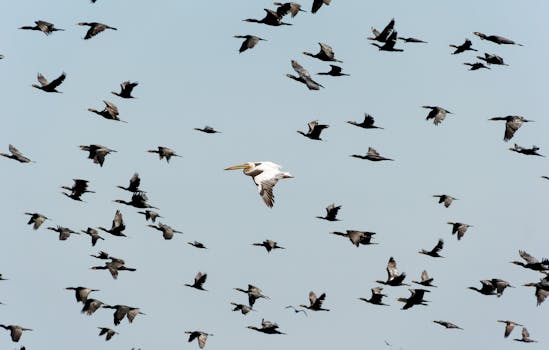The Mysteries of Bird Migration: How They Navigate and Travel Huge Distances Without Getting Lost
Bird migration is one of nature’s most fascinating phenomena, showcasing the incredible endurance and navigational skills of avian species. Every year, millions of birds embark on epic journeys, traveling thousands of miles between breeding and wintering grounds. But how do these creatures navigate such vast distances without getting lost? This article delves into the mysteries of bird migration, exploring the mechanisms behind their navigation and the challenges they face along the way.
The Great Migration: A Journey of Survival
Bird migration is primarily driven by the need for survival. As seasons change, food availability and breeding conditions fluctuate, prompting birds to migrate to more hospitable environments. Some of the most notable migratory birds include:
- The Arctic Tern, which travels over 44,000 miles annually between its breeding grounds in the Arctic and wintering sites in the Antarctic.
- The Common Swift, known for its remarkable non-stop flight of up to 10 months, covering vast distances across Europe and Africa.
- The Barn Swallow, which migrates from North America to Central and South America, showcasing adaptability to different climates.
These migrations are not just impressive feats of endurance; they are essential for the survival of these species, allowing them to exploit seasonal resources effectively.
How Do Birds Navigate?
The ability of birds to navigate during migration has long intrigued scientists. Research has identified several key mechanisms that birds use to find their way:
- Celestial Navigation: Many birds use the position of the sun during the day and the stars at night to orient themselves. For instance, studies have shown that migratory birds can adjust their flight paths based on the sun’s position, even when it is obscured by clouds.
- Magnetic Fields: Birds possess a unique ability to sense the Earth’s magnetic field, which helps them determine their geographical position. The European Robin, for example, has been shown to use magnetic cues to navigate during its long migrations.
- Landmarks: Birds often rely on visual cues from the landscape, such as mountains, rivers, and coastlines, to guide their journeys. This method is particularly useful for species that migrate shorter distances.
- Olfactory Cues: Recent studies suggest that some birds can use their sense of smell to navigate. For example, homing pigeons have been shown to rely on scent cues from their home environment to find their way back.
These navigation strategies are not mutually exclusive; many birds use a combination of these methods to ensure they stay on course during their migrations.
The Challenges of Migration
While migration is a remarkable adaptation, it is fraught with challenges. Birds face numerous obstacles that can impact their survival during these long journeys:
- Weather Conditions: Severe weather, such as storms and strong winds, can disrupt migration patterns and lead to disorientation.
- Habitat Loss: Urbanization and deforestation have reduced the availability of stopover sites, where birds rest and refuel during migration.
- Predation: Migrating birds are vulnerable to predators, both during their journey and at their stopover sites.
- Climate Change: Altered weather patterns and shifting food availability due to climate change can affect migration timing and routes.
These challenges highlight the importance of conservation efforts to protect migratory birds and their habitats, ensuring that they can continue their incredible journeys.
Conclusion: The Wonders of Migration
Bird migration is a testament to the resilience and adaptability of avian species. Through a combination of celestial navigation, magnetic sensing, visual landmarks, and olfactory cues, birds embark on remarkable journeys that span continents. However, they face numerous challenges that threaten their survival. Understanding the intricacies of bird migration not only deepens our appreciation for these creatures but also underscores the need for conservation efforts to protect their migratory routes and habitats. As we continue to study these fascinating phenomena, we gain valuable insights into the interconnectedness of ecosystems and the importance of preserving our natural world.
